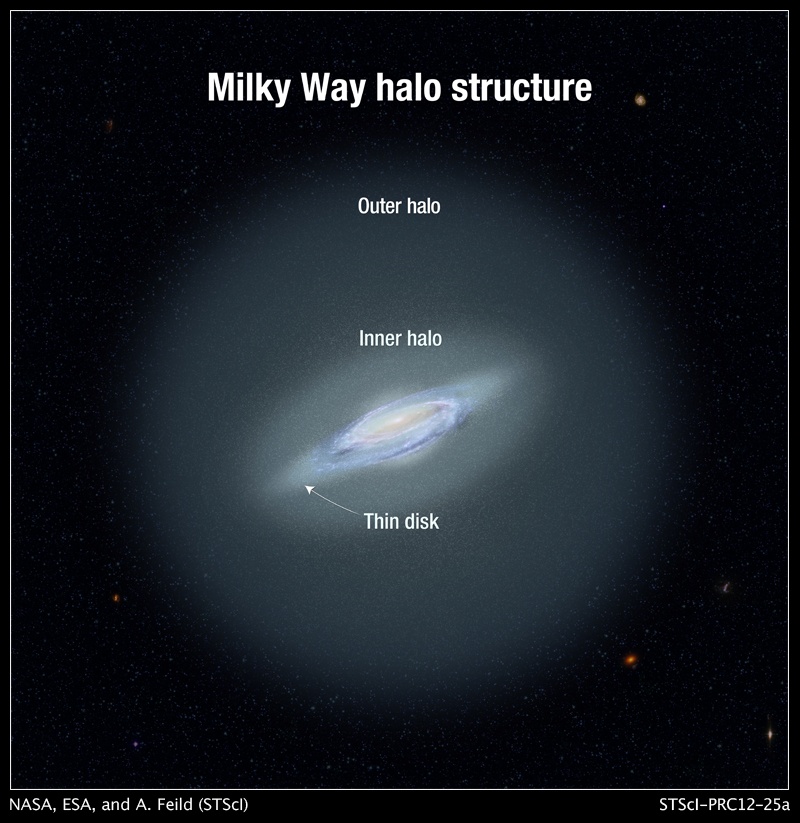We all know our galaxy, the Milky Way, is big. Really big. But, exactly how far out does it extend? Where are the outer limits? Astronomers aren’t exactly sure, precisely.
However, a study of galaxies in the Virgo Cluster accidentally turned up a population of stars in the outer part of the Milky Way. They may answer those questions. The stars, called RR Lyrae variables, lie in the galaxy’s stellar halo.
That’s a shell of stars and dark matter that extends at least halfway to the Andromeda Galaxy. It’s our nearest neighboring spiral and lies about 2. 5 million light-years away.
The newly found RR Lyraes orbit in the Milky Way’s outer halo at a distance of about 100 million light-years. And, because they’re variables that pulsate regularly in their brightness, astronomers can use them to determine accurate distances in space. Find the distances to these ancient pulsating variables and voila! You’ve found the distance to their position in the halo.
RR Lyrae stars are interesting in their own right, even beyond their role here as distance indicators. They have specific physical properties that cause them to expand and contract in a regularly repeating cycle. It’s almost like a heartbeat.
And, their average brightness is the same for all of them. That’s the characteristic that allows them to be used as standard distance “candles” across the gulfs of space. They’re often found in globular clusters.
Finding them in the stellar halo is an added plus for astronomers using them to determine the extent of the Milky Way. This image from European Southern Observatory shows several RR Lyrae stars. They typically reside in ancient stellar populations over 10 billion years old, in globular clusters, and in the halo.
Courtesy ESO/VVV Survey/D. Minniti. Milky Way Structure Astronomer Raja GuhaThakurta of the University of California Santa Cruz pointed out that studies of this new population of RR Lyraes carried out by student Yuting Feng clarify the “edge” of the Milky Way.
“This study is redefining what constitutes the outer limits of our galaxy,” he said. “[It] and Andromeda are both so big, there’s hardly any space between the two galaxies. ” The Milky Way has a core, arms, and a disk component that is divided into thick and thin sections.
We live in a spiral arm in the disk. Our neighborhood lies about 2/3 of the way out from the core—often referred to as the central bulge. It’s all surrounded by the stellar halo.
GuhaThakurta also explained that the galactic stellar halo is much bigger than the disk, It’s about 100,000 light-years across. The halo also contains the oldest stars in the galaxy. It extends for hundreds of thousands of light years in every direction.
“The halo is the hardest part to study because the outer limits are so far away,” GuhaThakurta said. “The stars are very sparse compared to the high stellar densities of the disk and the bulge, but the halo is dominated by dark matter and actually contains most of the mass of the galaxy. ” Looking at Galaxies and Finding Clues about Ours So, how to study this part of the galaxy if it’s so tough? And where do the RR Lyraes come in? Yuting Feng used survey studies of galaxies in the Virgo Cluster to dig out data about stars in our own galaxy and its halo.
Computer models show that this stellar halo should stretch out about a million light-years from the core of the galaxy. (That’s 300 kiloparsecs in astronomer-speak). But, astronomers needed more data.
Hence the use of survey data. The survey data Feng tapped is from the Next Generation Virgo Cluster Survey, a comprehensive optical imaging study of the cluster. It used the MegaCam instrument on the Canada-France-Hawaii Telescope (CFHT) on Mauna Kea.
The survey was proposed to study a variety of factors of the cluster, including mass, the intracluster medium, the fossil record of star formation in the cluster, and studies of galaxy haloes. To get a deep exposure of M87 and other Virgo Cluster galaxies, the telescope also captured foreground stars in our galaxy. “The data we used are sort of a by-product of that survey,” Feng explained.
“We were able to use these variable stars as reliable tracers to pin down the distances,” Feng said. “Our observations confirm the theoretical estimates of the size of the halo, so that’s an important result. ” The discovery of the RR Lyraes is significant, according to Feng.
That’s because astronomers have struggled to get reliable distance measurements in the region. “This robust sample of distant RR Lyrae stars gives us a very powerful tool for studying the halo and testing our current models of the size and mass of our galaxy,” Feng said. For More Information Astronomers find the most distant stars in our galaxy halfway to Andromeda The Next Generation Virgo Cluster Survey (NGVS) The post Newly Found Stars are Technically in the Milky Way, but They’re Halfway to Andromeda appeared first on Universe Today.
.
From: universetoday
URL: https://www.universetoday.com/159574/newly-found-stars-are-technically-in-the-milky-way-but-theyre-halfway-to-andromeda/



